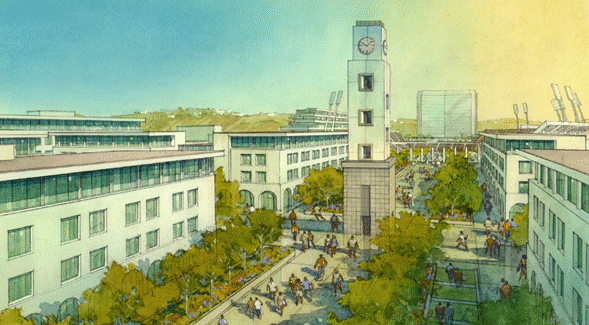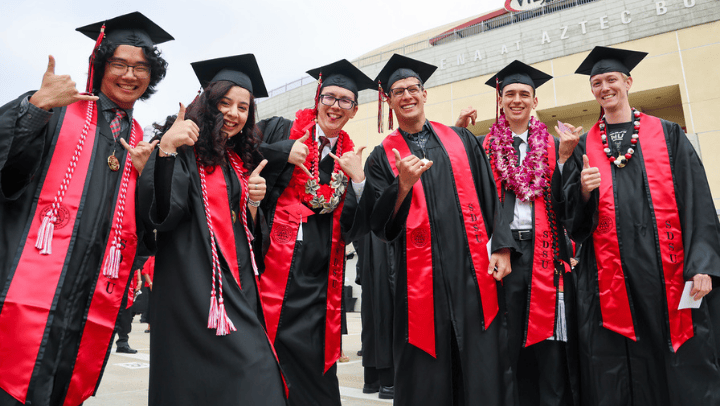The Logic of SDSU Mission Valley
SDSUs plans for a Mission Valley campus focus on collaboration, community and economic growth.

“We have contributed a lot to San Diego over the years, but we’ve only skimmed the surface of what’s possible.”
View the full SDSU Mission Valley site plan and architectural concepts at www.sdsu.edu/missionvalley.
This story appears in the spring 2018 issue of 360: The Magazine of San Diego State University.
San Diego’s Mission Valley has long been a land of plenty and promise. Now, the future of the valley’s bounty finds itself at a crossroads: One of the largest plots of undeveloped urban real estate in Southern California—currently occupied by SDCCU Stadium—is up for debate. If given the opportunity to purchase the land, San Diego State University aspires to build a world-class university campus, research center and stadium venue on the site.
The plans are extensive, but SDSU has never lacked ambition. During its 121-year history—including 87 years on Montezuma Mesa—SDSU evolved from a training school for teachers into a nationally ranked university offering joint doctoral degrees, rigorous academic programming and transformative opportunities to study abroad and develop entrepreneurial skills.
Throughout that time, the university also forged a personal and financial synergy with San Diego—personal because more than 200,000 SDSU alumni live in San Diego County, and financial because SDSU generates $5.67 billion in annual economic activity for the region, according to an independent study released last year.
“We have contributed a lot to San Diego over the years, but we’ve only skimmed the surface of what’s possible,” said Stephen Welter, SDSU’s vice president for research and dean of Graduate Affairs.
Space race
In order to make what’s possible a reality, the university needs more space. SDSU’s 288-acre campus is landlocked with a freeway to the north and suburban neighborhoods built up to the campus borders on the south, east and west. The shortage of classroom, lab, office and meeting space is evident, given SDSU’s enrollment of 30,000 undergraduate students and 4,000 graduate students.
SDSU envisions the Mission Valley site as a vibrant, mixed-use, medium-density development that is transit-oriented, and expands the university’s educational, research, entrepreneurial, and technology transfer programs.
The development would feature a river park and additional open-space areas; a multi-use sports stadium for football, professional soccer and entertainment events; student, faculty and staff housing as well as affordable and market-rate housing for the community; a research and innovation hub linking private industry partners with academic goals; and retail stores to serve the campus and neighborhood.
A conference center hotel is also part of the plan to accommodate campus visitors and train students in SDSU’s L. Robert Payne School of Hospitality and Tourism Management.
SDSU’s satellite campus on the Mission Valley site would include 1.6 million square feet of academic and innovative space located adjacent to the stadium to create an incubator-like feel and provide modern facilities for researchers. Faculty/staff office space, interdisciplinary research labs and community clinics staffed by SDSU graduate students and researchers are also envisioned.
Detailed plans for the Mission Valley site are intentionally flexible as the university actively seeks community input to ensure its plan is consistent with the objectives of the Mission Valley Community Plan and considerate of the city’s goals.
Voters in the City of San Diego will have the opportunity to decide in November whether to direct the city to sell the land to SDSU or to a private developer.
A regional asset
Supporters of SDSU Mission Valley believe the university will be the most conscientious proprietor of the site and a good steward of the land.
“There is no better use for the property,” said Bill Earley (‘86), San Diego community leader. “It fits into the expansion needs of higher education in San Diego and at SDSU specifically.”
Preliminary plans drafted by the architecture firm Carrier Johnson & Culture include 1.6 million square feet of dedicated campus space alongside nearly 90 acres of open space—including a river park—a new 35,000-seat multi-use stadium and 15 blocks of housing and retail space developed through public and private partnerships.
All told, the estimated cost of the project is about $3.8 billion. It will not rely on taxpayer dollars, student tuition or fees, and will cover its own costs through public-private partnerships or bonds paid back by revenue generated through the development.
“There are tremendous benefits to keeping the property within the public domain, where it can support the growth of San Diego State University and the region,” said Nikki Clay (’67, ’72), strategic counsel for The Clay Company and a board member of The Campanile Foundation, SDSU’s philanthropic auxiliary.
One of the most visible and pressing needs included in SDSU’s expansion plans is the stadium construction. The 50-year-old SDCCU Stadium has become too old and dilapidated to reliably host football games and other large events in the long term. SDSU’s plans for the site include a stadium to accommodate collegiate athletics, professional soccer and a wide variety of other events.
Magnet for top talent
Academically, a campus in Mission Valley makes perfect sense, said Stanley Maloy, SDSU’s associate vice president for research and innovation. The completion of the Engineering and Interdisciplinary Sciences (EIS) Complex was a significant step forward for the university’s research ambitions, doubling the classroom space available to engineering students and adding several modern lab facilities with state-of-the-art equipment, including the university’s first MRI brain imaging machine.
The EIS Complex will help SDSU attract high-quality faculty and students right now, Maloy said, but the next generation of top talent will expect more. That’s why the Mission Valley site is crucial. In addition to modern research space, dedicated and affordable housing on or close to campus for graduate students and new faculty can be a valuable recruitment tool.
“Expanding into Mission Valley will be critical to who we are and how we want to grow,” Maloy said. “It will allow us to become the best version of ourselves, to expand on what we do well.”
Partnering up
And what SDSU does better than anyone else in the region is build partnerships with the community. With more than 60 percent of SDSU graduates living and working in San Diego County, there’s an enormous network of skilled, successful alumni who know the value of partnering with the university. SDSU envisions a Mission Valley campus that promotes collaboration with local, national and international business partners, government agencies and nongovernmental organizations.
SDSU Mission Valley would be a meeting place for academic and business partners to discuss how research from SDSU labs would benefit their business, or how products dreamed up by SDSU entrepreneurs can make their way into consumers’ homes and workplaces. University officials have identified growing fields such as cybersecurity, artificial intelligence, biomedical research, health diagnostics, environmental monitoring, engineering and communications technology as potentially fruitful areas for public-private partnerships.
A dedicated conference center on site would allow the university to host annual meetings and conferences for scientific and business associations, not only enhancing SDSU’s academic reputation, but also giving its students and faculty “first dibs” on cutting-edge knowledge.
The central location of a Mission Valley campus would ease access to SDSU’s many community services, including various clinical programs like psychology, autism services and speech, language and hearing sciences,
Welter noted.
“We have the chance to build a very different kind of campus that doesn’t exist yet in the San Diego region—a campus without borders,” he said. “For years, academia has been locked into an ‘ivory tower’ mindset where you have to storm the ivory tower to benefit from what’s inside. What we’re trying to build is something like a public square to benefit the SDSU students, faculty, staff and the community.”
A river runs through it
Finally, the Mission Valley campus would help restore much of the region’s natural splendor. When builders broke ground on Jack Murphy Stadium in 1965, they severely altered the flow and hydrology of the San Diego River and its tributaries that ran through the site. Construction crews cut tons of dirt from the cliffs and built the stadium up on “the world’s largest pitching mound” to position it above the floodplain.
Then they tried to reroute the river’s flow around the massive asphalt parking lot, explained the SDSU Mission Valley plan’s principal architect, Gordon Carrier.
The river never really cooperated, he said, as evidenced by the fact that the site frequently floods during stormy weather. Carrier envisions restoring the river’s natural winds and bends within the Mission Valley river park and allowing the park itself to act as a natural floodplain. Allowing the river to dictate development means finger parks will bring nature and green space into the campus.
“If open space is done right, it can inspire thoughtful development, which sets the tone for the whole site,” Carrier said. “There are few, if any, opportunities to influence a region like this plan can influence San Diego. Mission Valley is really the epicenter of the entire community, and it’s immensely important to get it right.”
View the SDSU Mission Valley website to learn more about the site plan and view renderings.



